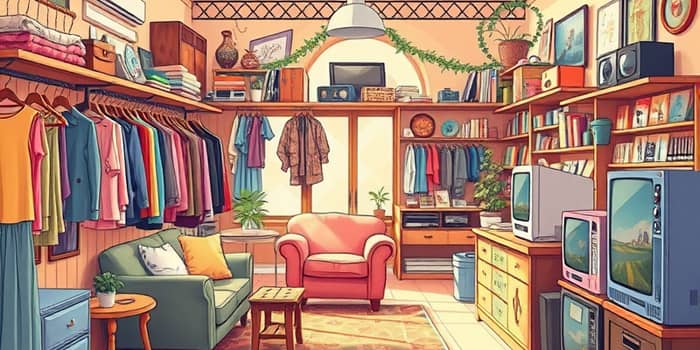When Maya stepped into a sunlit thrift shop downtown, she expected faded garments and outdated decor. Instead, she found a collection of timeless treasures at unbeatable prices. That day, she walked away not only with a designer jacket nearly as good as new, but also with a renewed belief that secondhand shopping can be a source of both style and purpose.
In an era where fast fashion dominates and environmental concerns loom large, the old stigma around “used” items is fading. Today’s secondhand market is booming, driven by consumers who demand quality, value, and sustainability. As you read on, you’ll discover why buying pre-loved doesn’t mean settling for less—instead, it means embracing smarter, more conscious shopping.
Quality Perception Versus Reality
Many shoppers assume that secondhand goods are inferior, but research paints a different picture. A 2024 survey found that 62% of shoppers believe pre-loved apparel offers better quality for the price than brand-new items. This perception shift is rooted in the fact that many lightly used goods—especially from reputable brands—retain their structure and style far longer than cheap, newly manufactured alternatives.
Consider these examples:
- Designer dresses worn only a handful of times.
- Solid wood furniture with decades of craftsmanship.
- Factory-refurbished electronics with reliable warranties.
In each case, the difference in performance or appearance can be minimal or even nonexistent when compared to fresh-off-the-shelf products.
Economic Advantages of Pre-Loved Purchases
One of the most compelling reasons to shop secondhand is simple: cost savings. By opting for pre-owned items, consumers can often pay 30–70% less than retail prices. Over the course of a year, those savings can add up significantly—allowing you to stretch your budget without compromising on quality.
Take electronics for instance. A factory-refurbished laptop may have been returned for a minor defect, but after professional servicing, it works like new. Yet it can sell for half the price of a brand-new model. Similar patterns emerge in home decor, where vintage and secondhand furnishings often cost a fraction of modern equivalents while offering unique character and durable construction.
Environmental and Social Impact
Beyond personal savings, secondhand shopping delivers profound environmental benefits. Every item reused is one less unit requiring new production—saving energy, water, and raw materials, while also reducing greenhouse gas emissions. According to market analysts, expanding the secondhand apparel sector alone could curb millions of tons of textile waste each year.
Moreover, choosing pre-loved goods fosters a more equitable consumption model, encouraging a culture of sharing and repair rather than disposal. It creates opportunities for local charities, small businesses, and artisans who rely on thrift stores and consignment shops, strengthening the social fabric of communities worldwide.
Digital Transformation and Accessibility
In decades past, secondhand shopping meant digging through dusty racks and hoping for a find. Today, online platforms have revolutionized the experience. Websites and apps offer advanced search filters, AI-driven recommendations, and secure payment systems—transforming resale into a seamless, trustworthy endeavor.
Features like live-streamed thrift hauls, digital product passports for traceability, and instant chat with sellers have raised the bar for customer confidence. Whether you’re searching for a rare vintage jacket or a gently used smartphone, you can browse thousands of listings at the click of a button, knowing that authenticity checks and return policies often safeguard your purchase.
Smart Shopping Tips and Precautions
While the opportunities are vast, successful secondhand shopping requires a bit of strategy. Follow these guidelines to make the most of your pre-loved purchases:
- Inspect for wear and authenticity before committing.
- Research platform return policies and seller ratings.
- Avoid high-risk items like car seats or mattresses where safety is paramount.
When in doubt, seek out reputable stores or certified refurbishers that offer warranties. This approach ensures you enjoy the benefits of secondhand deals with peace of mind.
Secondhand vs. New: A Comparative Glance
To illustrate the practical differences, consider this snapshot across common categories:
Embracing a Circular Future
The momentum behind secondhand isn’t a fleeting trend—it’s part of a fundamental shift toward a circular economy. Major brands are now building resale channels into their business models, offering trade-in credits and certified pre-owned programs. Governments are encouraging reuse and repair through policy incentives, making sustainable choices ever more accessible.
By choosing secondhand, you become part of a collective movement that values resourcefulness over waste. You send a powerful message: that style and quality need not come at the expense of the planet.
As Maya discovered that afternoon, secondhand treasures can ignite joy, creativity, and mindful living. Whether you’re hunting for a statement piece or upgrading everyday essentials, remember that pre-loved items are more than just bargains—they’re a pathway to a smarter, greener, and more connected world. Your next great find is waiting—will you embrace it?
References
- https://www.fashiondive.com/news/secondhand-recommerce-offerup-2024-report/728429/
- https://www.rd.com/list/buy-used/
- https://smartasset.com/personal-finance/new-vs-used-8-things-youre-better-off-buying-secondhand
- https://www.merecyclers.com/new-or-used-4-reasons-why-you-should-shop-second-hand/
- https://www.reviewjournal.com/business/9-times-its-ok-to-buy-used-instead-of-new/
- https://www.futuremarketinsights.com/reports/secondhand-apparel-market
- https://opentextbc.ca/writingforsuccess/chapter/chapter-9-citations-and-referencing/
- https://www.consumerreports.org/money/saving-money/expert-tips-for-buying-secondhand-products-to-save-you-money-a7940674189/










